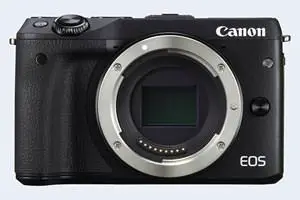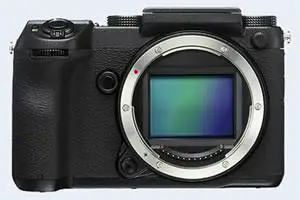Canon M3 vs Fujifilm GFX 50S
The Canon EOS M3 and the Fujifilm GFX 50S are two digital cameras that were officially introduced, respectively, in February 2015 and September 2016. Both the M3 and the GFX 50S are mirrorless interchangeable lens cameras that are based on an APS-C (M3) and a medium format (GFX 50S) sensor. The Canon has a resolution of 24 megapixels, whereas the Fujifilm provides 51.1 MP.
Below is an overview of the main specs of the two cameras as a starting point for the comparison.

Check M3 offers at
ebay.com

Check GFX 50S offers at
ebay.com
Going beyond this snapshot of core features and characteristics, what are the differences between the Canon EOS M3 and the Fujifilm GFX 50S? Which one should you buy? Read on to find out how these two cameras compare with respect to their body size, their imaging sensors, their shooting features, their input-output connections, and their reception by expert reviewers.
Body comparison
The side-by-side display below illustrates the physical size and weight of the Canon M3 and the Fujifilm GFX 50S. The two cameras are presented according to their relative size. Three successive views from the front, the top, and the rear are shown. All width, height and depth dimensions are rounded to the nearest millimeter.
The M3 can be obtained in two different colors (black, white), while the GFX 50S is only available in black.
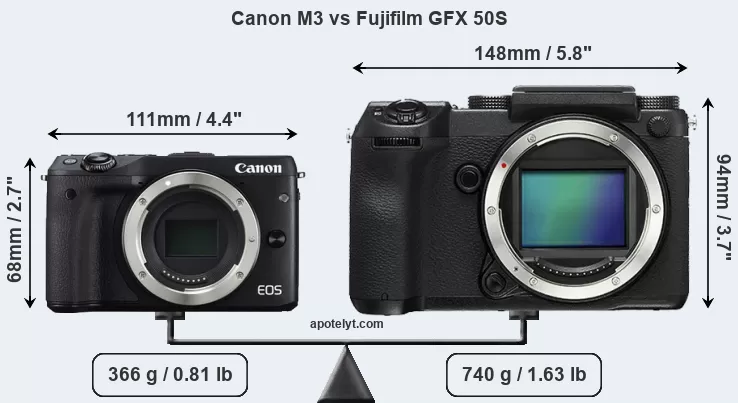
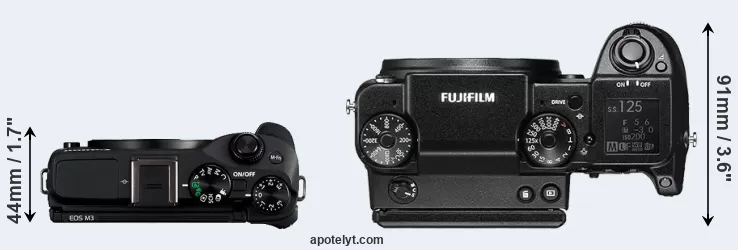
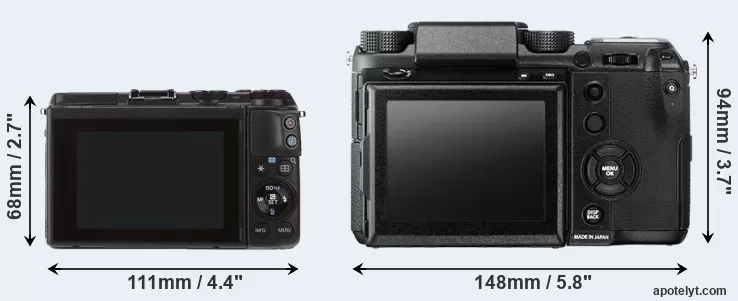
If the front view area (width x height) of the cameras is taken as an aggregate measure of their size, the Fujifilm GFX 50S is considerably larger (84 percent) than the Canon M3. Moreover, the GFX 50S is substantially heavier (102 percent) than the M3. It is noteworthy in this context that the GFX 50S is splash and dust-proof, while the M3 does not feature any corresponding weather-sealing.
The above size and weight comparisons are to some extent incomplete since they do not consider the interchangeable lenses that both of these cameras require. Hence, you might want to study and compare the specifications of available lenses in order to get the full picture of the size and weight of the two camera systems.
Concerning battery life, the M3 gets 250 shots out of its Canon LP-E17 battery, while the GFX 50S can take 400 images on a single charge of its Fujifilm NP-T125 power pack.
The following table provides a synthesis of the main physical specifications of the two cameras and other similar ones. In case you want to display and compare another camera duo, you can use the CAM-parator app to select your camera combination among a large number of options.

| # | Camera Model |
Camera Width |
Camera Height |
Camera Depth |
Camera Weight |
Battery Life |
Weather Sealing |
Camera Launch |
Launch Price (USD) |
Street Price |
|
|---|---|---|---|---|---|---|---|---|---|---|---|
| 1. | Canon M3 | 111 mm | 68 mm | 44 mm | 366 g | 250 | n | Feb 2015 | 679 | ebay.com | |
| 2. | Fujifilm GFX 50S | 148 mm | 94 mm | 91 mm | 740 g | 400 | Y | Sep 2016 | 6,499 | ebay.com | |
| 3. | Canon M50 Mark II | 116 mm | 88 mm | 59 mm | 387 g | 305 | n | Oct 2020 | 599 | ebay.com | |
| 4. | Canon M50 | 116 mm | 88 mm | 59 mm | 390 g | 235 | n | Feb 2018 | 779 | ebay.com | |
| 5. | Canon M6 | 112 mm | 68 mm | 45 mm | 390 g | 295 | n | Feb 2017 | 779 | ebay.com | |
| 6. | Canon M100 | 108 mm | 67 mm | 35 mm | 302 g | 295 | n | Aug 2017 | 499 | ebay.com | |
| 7. | Canon M5 | 116 mm | 89 mm | 61 mm | 427 g | 295 | n | Sep 2016 | 979 | ebay.com | |
| 8. | Canon G5 X | 112 mm | 76 mm | 44 mm | 353 g | 210 | n | Oct 2015 | 799 | ebay.com | |
| 9. | Canon T6i | 132 mm | 101 mm | 78 mm | 555 g | 440 | n | Feb 2015 | 749 | ebay.com | |
| 10. | Canon T6s | 132 mm | 101 mm | 78 mm | 565 g | 440 | n | Feb 2015 | 649 | ebay.com | |
| 11. | Canon G7 X | 103 mm | 60 mm | 40 mm | 304 g | 210 | n | Sep 2014 | 699 | ebay.com | |
| 12. | Canon M | 109 mm | 66 mm | 32 mm | 298 g | 230 | n | Jul 2012 | 599 | ebay.com | |
| 13. | Fujifilm GFX 50S II | 150 mm | 104 mm | 87 mm | 900 g | 440 | Y | Sep 2021 | 3,999 | amazon.com | |
| 14. | Fujifilm GFX 50R | 161 mm | 97 mm | 66 mm | 775 g | 400 | Y | Sep 2018 | 4,499 | ebay.com | |
| 15. | Hasselblad X1D II | 148 mm | 97 mm | 70 mm | 766 g | .. | Y | Jun 2019 | 5,750 | ebay.com | |
| 16. | Leica M10 | 139 mm | 80 mm | 39 mm | 660 g | 210 | Y | Jan 2017 | 6,595 | ebay.com | |
| 17. | Leica SL | 147 mm | 104 mm | 39 mm | 847 g | 400 | Y | Oct 2015 | 7,450 | ebay.com | |
| Note: Measurements and pricing do not include easily detachable parts, such as add-on or interchangeable lenses or optional viewfinders. | |||||||||||
Any camera decision will naturally be influenced heavily by the price. The listed launch prices provide an indication of the market segment that the manufacturer of the cameras have been targeting. The M3 was launched at a markedly lower price (by 90 percent) than the GFX 50S, which puts it into a different market segment. Usually, retail prices stay at first close to the launch price, but after several months, discounts become available. Later in the product cycle and, in particular, when the replacement model is about to appear, further discounting and stock clearance sales often push the camera price considerably down.
Sensor comparison
The size of the imaging sensor is a crucial determinant of image quality. A large sensor will generally have larger individual pixels that offer better low-light sensitivity, provide wider dynamic range, and have richer color-depth than smaller pixels in a sensor of the same technological generation. Moreover, a large sensor camera will give the photographer more control over depth-of-field in the image and, thus, the ability to better isolate a subject from the background. On the downside, larger sensors are more costly to manufacture and tend to lead to bigger and heavier cameras and lenses.
Of the two cameras under consideration, the Canon M3 features an APS-C sensor and the Fujifilm GFX 50S a medium format sensor. The sensor area in the GFX 50S is 337 percent bigger. As a result of these sensor size differences, the cameras have a format factor of, respectively, 1.6 and 0.79. The sensor in the M3 has a native 3:2 aspect ratio, while the one in the GFX 50S offers a 4:3 aspect.
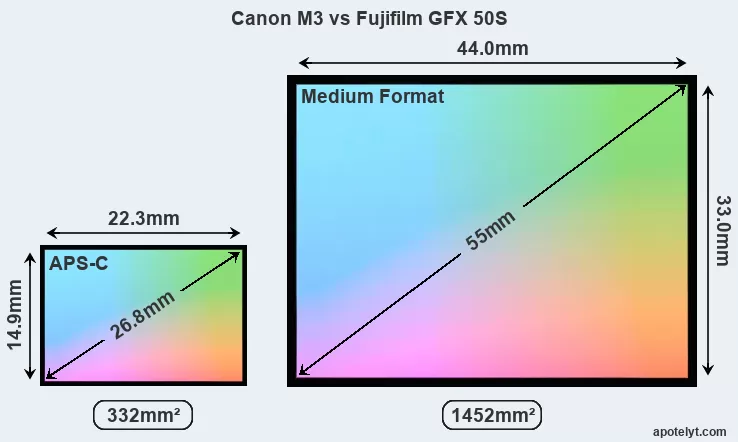
With 51.1MP, the GFX 50S offers a higher resolution than the M3 (24MP), but the GFX 50S nevertheless has larger individual pixels (pixel pitch of 5.33μm versus 3.72μm for the M3) due to its larger sensor. Moreover, the GFX 50S is a somewhat more recent model (by 1 year and 7 months) than the M3, and its sensor might have benefitted from technological advances during this time that further enhance the light gathering capacity of its pixel-units. Coming back to sensor resolution, it should be mentioned that the GFX 50S has no anti-alias filter installed, so that it can capture all the detail its sensor resolves.
The resolution advantage of the Fujifilm GFX 50S implies greater flexibility for cropping images or the possibility to print larger pictures. The maximum print size of the GFX 50S for good quality output (200 dots per inch) amounts to 41.3 x 31 inches or 104.9 x 78.6 cm, for very good quality (250 dpi) 33 x 24.8 inches or 83.9 x 62.9 cm, and for excellent quality (300 dpi) 27.5 x 20.6 inches or 69.9 x 52.4 cm. The corresponding values for the Canon M3 are 30 x 20 inches or 76.2 x 50.8 cm for good quality, 24 x 16 inches or 61 x 40.6 cm for very good quality, and 20 x 13.3 inches or 50.8 x 33.9 cm for excellent quality prints.
The M3 has on-sensor phase detect pixels, which results in fast and reliable autofocus acquisition even during live view operation.
The Canon EOS M3 has a native sensitivity range from ISO 100 to ISO 12800, which can be extended to ISO 100-25600. The corresponding ISO settings for the Fujifilm GFX 50S are ISO 100 to ISO 12800, with the possibility to increase the ISO range to 50-102400.
Technology-wise, both cameras are equipped with CMOS (Complementary Metal–Oxide–Semiconductor) sensors. Both cameras use a Bayer filter for capturing RGB colors on a square grid of photosensors. This arrangement is found in most digital cameras.
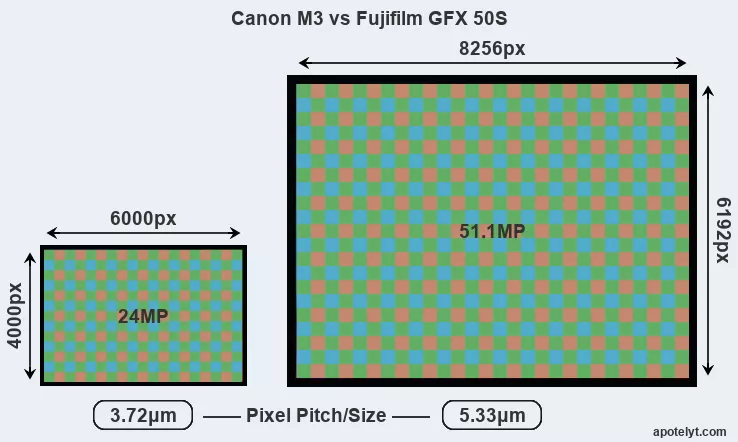
Consistent information on actual sensor performance is available from DXO Mark for many cameras. This service determines an overall sensor rating, as well as sub-scores for low-light sensitivity ("DXO Sports"), dynamic range ("DXO Landscape"), and color depth ("DXO Portrait"). The following table provides an overview of the physical sensor characteristics, as well as the sensor quality measurements for a selection of comparators.

| # | Camera Model |
Sensor Class |
Resolution (MP) |
Horiz. Pixels |
Vert. Pixels |
Video Format |
DXO Portrait |
DXO Landscape |
DXO Sports |
DXO Overall |
|
|---|---|---|---|---|---|---|---|---|---|---|---|
| 1. | Canon M3 | APS-C | 24.0 | 6000 | 4000 | 1080/30p | 22.8 | 11.8 | 1169 | 72 | |
| 2. | Fujifilm GFX 50S | Medium Format | 51.1 | 8256 | 6192 | 1080/30p | 25.4 | 14.1 | 2977 | 96 | |
| 3. | Canon M50 Mark II | APS-C | 24.0 | 6000 | 4000 | 4K/24p | 24.0 | 13.6 | 1939 | 83 | |
| 4. | Canon M50 | APS-C | 24.0 | 6000 | 4000 | 4K/24p | 23.8 | 13.3 | 1684 | 81 | |
| 5. | Canon M6 | APS-C | 24.0 | 6000 | 4000 | 1080/60p | 23.4 | 12.6 | 1317 | 78 | |
| 6. | Canon M100 | APS-C | 24.0 | 6000 | 4000 | 1080/60p | 23.5 | 12.9 | 1272 | 78 | |
| 7. | Canon M5 | APS-C | 24.0 | 6000 | 4000 | 1080/60p | 23.4 | 12.4 | 1262 | 77 | |
| 8. | Canon G5 X | 1-inch | 20.0 | 5472 | 3648 | 1080/60p | 21.4 | 12.3 | 471 | 62 | |
| 9. | Canon T6i | APS-C | 24.0 | 6000 | 4000 | 1080/30p | 22.7 | 12.0 | 919 | 71 | |
| 10. | Canon T6s | APS-C | 24.0 | 6000 | 4000 | 1080/30p | 22.6 | 12.0 | 915 | 70 | |
| 11. | Canon G7 X | 1-inch | 20.0 | 5472 | 3648 | 1080/60p | 23.0 | 12.7 | 556 | 71 | |
| 12. | Canon M | APS-C | 17.9 | 5184 | 3456 | 1080/30p | 22.1 | 11.2 | 827 | 65 | |
| 13. | Fujifilm GFX 50S II | Medium Format | 51.1 | 8256 | 6192 | 1080/30p | 25.9 | 14.8 | 3456 | 100 | |
| 14. | Fujifilm GFX 50R | Medium Format | 51.1 | 8256 | 6192 | 1080/30p | 25.7 | 14.4 | 3169 | 98 | |
| 15. | Hasselblad X1D II | Medium Format | 51.3 | 8272 | 6200 | 1080/25p | 25.7 | 14.5 | 3234 | 99 | |
| 16. | Leica M10 | Full Frame | 23.8 | 5952 | 3992 | none | 24.4 | 13.2 | 2133 | 86 | |
| 17. | Leica SL | Full Frame | 24.0 | 6000 | 4000 | 4K/30p | 25.0 | 13.4 | 1821 | 88 | |
| Note: DXO values in italics represent estimates based on sensor size and age. | |||||||||||
Many modern cameras are not only capable of taking still images, but also of capturing video footage. Both cameras under consideration have a sensor with sufficiently fast read-out times for moving pictures, and both provide the same movie specifications (1080/30p).
Feature comparison
Apart from body and sensor, cameras can and do differ across a range of features. The M3 and the GFX 50S are similar in the sense that neither of the two has a viewfinder. The images are, thus, framed using live view on the rear LCD. However, optional viewfinders – the EVF-DC1 for the M3 and the EVF-TL1 for the GFX 50S – are available as accessories. The following table reports on some other key feature differences and similarities of the Canon M3, the Fujifilm GFX 50S, and comparable cameras.

| # | Camera Model |
Viewfinder (Type or 000 dots) |
Control Panel (yes/no) |
LCD Specifications (inch/000 dots) |
LCD Attach- ment |
Touch Screen (yes/no) |
Max Shutter Speed * |
Max Shutter Flaps * |
Built-in Flash (yes/no) |
Built-in Image Stab |
|
|---|---|---|---|---|---|---|---|---|---|---|---|
| 1. | Canon M3 | optional | n | 3.0 / 1040 | tilting | Y | 1/4000s | 4.2/s | Y | n | |
| 2. | Fujifilm GFX 50S | optional | Y | 3.2 / 2360 | full-flex | Y | 1/4000s | 3.0/s | n | n | |
| 3. | Canon M50 Mark II | 2360 | n | 3.0 / 1040 | swivel | Y | 1/4000s | 10.0/s | Y | n | |
| 4. | Canon M50 | 2360 | n | 3.0 / 1040 | swivel | Y | 1/4000s | 10.0/s | Y | n | |
| 5. | Canon M6 | optional | n | 3.0 / 1040 | tilting | Y | 1/4000s | 9.0/s | Y | n | |
| 6. | Canon M100 | none | n | 3.0 / 1040 | tilting | Y | 1/4000s | 6.1/s | Y | n | |
| 7. | Canon M5 | 2360 | n | 3.2 / 1620 | tilting | Y | 1/4000s | 9.0/s | Y | n | |
| 8. | Canon G5 X | 2360 | n | 3.0 / 1040 | swivel | Y | 1/2000s | 5.9/s | Y | Y | |
| 9. | Canon T6i | optical | n | 3.0 / 1040 | swivel | Y | 1/4000s | 5.0/s | Y | n | |
| 10. | Canon T6s | optical | Y | 3.0 / 1040 | swivel | Y | 1/4000s | 5.0/s | Y | n | |
| 11. | Canon G7 X | none | n | 3.0 / 1040 | tilting | Y | 1/2000s | 6.5/s | Y | Y | |
| 12. | Canon M | none | n | 3.0 / 1040 | fixed | Y | 1/4000s | 4.3/s | n | n | |
| 13. | Fujifilm GFX 50S II | 3690 | Y | 3.2 / 2360 | full-flex | Y | 1/4000s | 3.0/s | n | Y | |
| 14. | Fujifilm GFX 50R | 3690 | n | 3.2 / 2360 | tilting | Y | 1/4000s | 3.0/s | n | n | |
| 15. | Hasselblad X1D II | 3690 | n | 3.6 / 2360 | fixed | Y | 1/2000s | 2.7/s | n | n | |
| 16. | Leica M10 | optical | n | 3.0 / 1037 | fixed | n | 1/4000s | 5.0/s | n | n | |
| 17. | Leica SL | 4400 | Y | 3.0 / 1040 | fixed | Y | 1/8000s | 11.0/s | n | n | |
| Note: *) Information refers to the mechanical shutter, unless the camera only has an electronic one. | |||||||||||
One difference between the cameras concerns the presence of an on-board flash. The M3 has one, while the GFX 50S does not. While the built-in flash of the M3 is not very powerful, it can at times be useful as a fill-in light.
The M3 has an articulated LCD that can be turned to be front-facing. This characteristic will be appreciated by vloggers and photographers who are interested in snapping selfies. In contrast, the GFX 50S does not have a selfie-screen.The reported shutter speed information refers to the use of the mechanical shutter. Yet, some cameras only have an electronic shutter, while others have an electronic shutter in addition to a mechanical one. In fact, the GFX 50S is one of those camera that have an additional electronic shutter, which makes completely silent shooting possible. However, this mode is less suitable for photographing moving objects (risk of rolling shutter) or shooting under artificial light sources (risk of flickering).
The Fujifilm GFX 50S has an intervalometer built-in. This enables the photographer to capture time lapse sequences, such as flower blooming, a sunset or moon rise, without purchasing an external camera trigger and related software.
Concerning the storage of imaging data, both the M3 and the GFX 50S write their files to SDXC cards. The GFX 50S features dual card slots, which can be very useful in case a memory card fails. In contrast, the M3 only has one slot. The GFX 50S supports UHS-II cards (on both slots), while the M3 can use UHS-I cards.
Connectivity comparison
For some imaging applications, the extent to which a camera can communicate with its environment can be an important aspect in the camera decision process. The table below provides an overview of the connectivity of the Canon EOS M3 and Fujifilm GFX 50S and, in particular, the interfaces the cameras (and selected comparators) provide for accessory control and data transfer.

| # | Camera Model |
Hotshoe Port |
Internal Mic / Speaker |
Microphone Port |
Headphone Port |
HDMI Port |
USB Port |
WiFi Support |
NFC Support |
Bluetooth Support |
|
|---|---|---|---|---|---|---|---|---|---|---|---|
| 1. | Canon M3 | Y | stereo / mono | Y | - | mini | 2.0 | Y | Y | - | |
| 2. | Fujifilm GFX 50S | Y | stereo / mono | Y | Y | micro | 3.0 | Y | - | - | |
| 3. | Canon M50 Mark II | Y | stereo / mono | Y | - | micro | 2.0 | Y | - | Y | |
| 4. | Canon M50 | Y | stereo / mono | Y | - | micro | 2.0 | Y | - | Y | |
| 5. | Canon M6 | Y | stereo / mono | Y | - | mini | 2.0 | Y | Y | Y | |
| 6. | Canon M100 | - | stereo / mono | - | - | micro | 2.0 | Y | Y | Y | |
| 7. | Canon M5 | Y | stereo / mono | Y | - | mini | 2.0 | Y | Y | Y | |
| 8. | Canon G5 X | Y | stereo / mono | - | - | mini | 2.0 | Y | Y | - | |
| 9. | Canon T6i | Y | stereo / mono | Y | - | mini | 2.0 | Y | Y | - | |
| 10. | Canon T6s | Y | stereo / mono | Y | - | mini | 2.0 | Y | Y | - | |
| 11. | Canon G7 X | - | stereo / mono | - | - | micro | 2.0 | Y | Y | - | |
| 12. | Canon M | Y | stereo / mono | Y | - | mini | 2.0 | - | - | - | |
| 13. | Fujifilm GFX 50S II | Y | stereo / mono | Y | Y | micro | 3.2 | Y | - | - | |
| 14. | Fujifilm GFX 50R | Y | stereo / mono | Y | Y | micro | 3.0 | Y | - | Y | |
| 15. | Hasselblad X1D II | Y | stereo / mono | Y | Y | - | 3.0 | Y | - | - | |
| 16. | Leica M10 | Y | - / - | - | - | - | - | Y | - | - | |
| 17. | Leica SL | Y | stereo / mono | Y | Y | full | 3.0 | Y | - | - |
It is notable that the GFX 50S has a headphone jack, which makes it possible to attach external headphones and monitor the quality of sound during the recording process. The M3 lacks such a headphone port.
Studio photographers will appreciate that the Fujifilm GFX 50S (unlike the M3) features a PC Sync socket, so that professional strobe lights can be controlled by the camera.
Both the M3 and the GFX 50S have been discontinued, but can regularly be found used on ebay. The M3 was replaced by the Canon M6, while the GFX 50S was followed by the Fujifilm GFX 50S II. Further information on the features and operation of the M3 and GFX 50S can be found, respectively, in the Canon M3 Manual (free pdf) or the online Fujifilm GFX 50S Manual.
Review summary
So what conclusions can be drawn? Which of the two cameras – the Canon M3 or the Fujifilm GFX 50S – has the upper hand? Is one clearly better than the other? Below is a summary of the relative strengths of each of the two contestants.

Reasons to prefer the Canon EOS M3:
- Better moiré control: Has an anti-alias filter to avoid artificial patterns to appear in images.
- Better live-view autofocus: Features on-sensor phase-detection for more confident autofocus.
- More selfie-friendly: Has an articulated screen that can be turned to be front-facing.
- Faster burst: Shoots at higher frequency (4.2 vs 3 flaps/sec) to capture the decisive moment.
- More compact: Is smaller (111x68mm vs 148x94mm) and thus needs less room in the bag.
- Less heavy: Is lighter (by 374g or 51 percent) and hence easier to carry around.
- Easier fill-in: Is equipped with a small onboard flash to brighten deep shadow areas.
- Easier device pairing: Supports NFC for fast wireless image transfer over short distances.
- More affordable: Was introduced into a lower priced category (90 percent cheaper at launch).
- More heavily discounted: Has been on the market for longer (launched in February 2015).

Arguments in favor of the Fujifilm GFX 50S:
- More detail: Has more megapixels (51.1 vs 24MP), which boosts linear resolution by 43%.
- Maximized detail: Lacks an anti-alias filter to exploit the sensor's full resolution potential.
- Better image quality: Is equipped with a larger and more technologically advanced sensor.
- Richer colors: The sensor size advantage translates into images with better, more accurate colors.
- More dynamic range: Larger sensor captures a wider spectrum of light and dark details.
- Better low-light sensitivity: Larger sensor produces good images even in poorly lit environments.
- Better sound control: Has a headphone port that enables audio monitoring while recording.
- Easier setting verification: Features a control panel on top to check shooting parameters.
- Larger screen: Has a bigger rear LCD (3.2" vs 3.0") for image review and settings control.
- More detailed LCD: Has a higher resolution rear screen (2360k vs 1040k dots).
- More flexible LCD: Has a full-flex screen for odd-angle shots in portrait or landscape orientation.
- Less disturbing: Has an electronic shutter option for completely silent shooting.
- Easier time-lapse photography: Has an intervalometer built-in for low frequency shooting.
- Longer lasting: Gets more shots (400 versus 250) out of a single battery charge.
- Better sealing: Is splash and dust sealed for shooting in inclement weather conditions.
- Faster data transfer: Supports a more advanced USB protocol (3.0 vs 2.0).
- Better studio light control: Has a PC Sync socket to connect to professional strobe lights.
- Greater peace of mind: Features a second card slot as a backup in case of memory card failure.
- Faster buffer clearing: Supports a more advanced SD data transfer standard (UHS-II vs UHS-I).
- More modern: Was introduced somewhat (1 year and 7 months) more recently.
If the number of relative strengths (bullet points above) is taken as a guide, the GFX 50S is the clear winner of the contest (20 : 10 points). However, the relevance of individual strengths will vary across photographers, so that you might want to apply your own weighing scheme to the summary points when reflecting and deciding on a new camera. A professional wildlife photographer will view the differences between cameras in a way that diverges from the perspective of a family photog, and a person interested in architecture has distinct needs from a sports shooter. Hence, the decision which camera is best and worth buying is often a very personal one.
How about other alternatives? Do the specifications of the Canon M3 and the Fujifilm GFX 50S place the cameras among the top in their class? Find out in the latest Best Mirrorless Interchangeable Lens Camera listing whether the two cameras rank among the cream of the crop.
In any case, while the specs-based evaluation of cameras can be instructive in revealing their potential as photographic tools, it remains partial and cannot reveal, for example, the shooting experience and imaging performance when actually working with the M3 or the GFX 50S. At times, user reviews, such as those published at amazon, address these issues in a useful manner, but such feedback is on many occasions incomplete, inconsistent, and unreliable.
Expert reviews
This is why expert reviews are important. The table below provides a synthesis of the camera assessments of some of the best known photo-gear review sites (amateurphotographer [AP], cameralabs [CL], digitalcameraworld [DCW], dpreview [DPR], ephotozine [EPZ], photographyblog [PB]). As can be seen, the professional reviewers agree in many cases on the quality of different cameras, but sometimes their assessments diverge, reinforcing the earlier point that a camera decision is often a very personal choice.

| # | Camera Model |
AP score |
CL score |
DCW score |
DPR score |
EPZ score |
PB score |
Camera Launch |
Launch Price (USD) |
Street Price |
|
|---|---|---|---|---|---|---|---|---|---|---|---|
| 1. | Canon M3 | 4/5 | o | .. | 75/100 | 4.5/5 | 4/5 | Feb 2015 | 679 | ebay.com | |
| 2. | Fujifilm GFX 50S | .. | .. | 4.5/5 | 85/100 | 5/5 | 4.5/5 | Sep 2016 | 6,499 | ebay.com | |
| 3. | Canon M50 Mark II | 4/5 | .. | 4/5 | .. | 4.5/5 | 3.5/5 | Oct 2020 | 599 | ebay.com | |
| 4. | Canon M50 | .. | + | 4/5 | 79/100 | .. | 3.5/5 | Feb 2018 | 779 | ebay.com | |
| 5. | Canon M6 | .. | .. | .. | 80/100 | 4/5 | 4/5 | Feb 2017 | 779 | ebay.com | |
| 6. | Canon M100 | 3/5 | + | .. | .. | 4/5 | 3.5/5 | Aug 2017 | 499 | ebay.com | |
| 7. | Canon M5 | 4/5 | + | 4/5 | 82/100 | 4/5 | 4/5 | Sep 2016 | 979 | ebay.com | |
| 8. | Canon G5 X | 5/5 | + + | .. | 78/100 | 4.5/5 | 4.5/5 | Oct 2015 | 799 | ebay.com | |
| 9. | Canon T6i | 5/5 | .. | .. | 75/100 | 4.5/5 | 4.5/5 | Feb 2015 | 749 | ebay.com | |
| 10. | Canon T6s | 5/5 | + | .. | 77/100 | 4.5/5 | 4.5/5 | Feb 2015 | 649 | ebay.com | |
| 11. | Canon G7 X | 4/5 | + + | .. | 77/100 | 4.5/5 | 4.5/5 | Sep 2014 | 699 | ebay.com | |
| 12. | Canon M | 3/5 | + | .. | .. | 4/5 | 4/5 | Jul 2012 | 599 | ebay.com | |
| 13. | Fujifilm GFX 50S II | 5/5 | .. | 5/5 | 87/100 | .. | 5/5 | Sep 2021 | 3,999 | amazon.com | |
| 14. | Fujifilm GFX 50R | 5/5 | .. | 5/5 | 84/100 | 4.5/5 | 4.5/5 | Sep 2018 | 4,499 | ebay.com | |
| 15. | Hasselblad X1D II | .. | .. | 4/5 | .. | 4/5 | 4/5 | Jun 2019 | 5,750 | ebay.com | |
| 16. | Leica M10 | 4.5/5 | .. | .. | .. | 4/5 | 4.5/5 | Jan 2017 | 6,595 | ebay.com | |
| 17. | Leica SL | 4/5 | .. | 4/5 | 84/100 | 4.5/5 | 4/5 | Oct 2015 | 7,450 | ebay.com | |
| Note: (+ +) highly recommended; (+) recommended; (o) reviewed; (..) not available. | |||||||||||
Care should be taken when interpreting the review scores above, though. The ratings were established in reference to similarly priced cameras that were available in the market at the time of the review. Hence, a score should always be seen in the context of the camera's market launch date and its price, and comparing ratings of very distinct cameras or ones that are far apart in terms of their release date have little meaning. It should also be noted that some of the review sites have over time altered the way they render their verdicts.

Check M3 offers at
ebay.com

Check GFX 50S offers at
ebay.com
Other camera comparisons
Did this review help to inform your camera decision process? In case you are interested in seeing how other cameras pair up, just make your choice using the following search menu. Alternatively, you can follow any of the listed hyperlinks for comparisons that others found interesting.
- Canon 1D Mark III vs Canon M3
- Canon 50D vs Canon M3
- Canon G1 X Mark III vs Fujifilm GFX 50S
- Canon G7 X Mark II vs Canon M3
- Canon M3 vs Leica V-LUX 2
- Canon M3 vs Nikon D80
- Canon M3 vs Panasonic GM1
- Canon M5 vs Fujifilm GFX 50S
- Canon T6 vs Fujifilm GFX 50S
- Canon XTi vs Fujifilm GFX 50S
- Fujifilm GFX 50S vs Fujifilm X-T1
- Fujifilm GFX 50S vs Sony A7 III
Specifications: Canon M3 vs Fujifilm GFX 50S
Below is a side-by-side comparison of the specs of the two cameras to facilitate a quick review of their differences and common features.
| Camera Model | Canon M3 | Fujifilm GFX 50S |
|---|---|---|
| Camera Type | Mirrorless system camera | Mirrorless system camera |
| Camera Lens | Canon EF-M mount lenses | Fujifilm G mount lenses |
| Launch Date | February 2015 | September 2016 |
| Launch Price | USD 679 | USD 6,499 |
| Sensor Specs | Canon M3 | Fujifilm GFX 50S |
| Sensor Technology | CMOS | CMOS |
| Sensor Format | APS-C Sensor | Medium Format Sensor |
| Sensor Size | 22.3 x 14.9 mm | 44.0 x 33.0 mm |
| Sensor Area | 332.27 mm2 | 1452 mm2 |
| Sensor Diagonal | 26.8 mm | 55 mm |
| Crop Factor | 1.6x | 0.79x |
| Sensor Resolution | 24 Megapixels | 51.1 Megapixels |
| Image Resolution | 6000 x 4000 pixels | 8256 x 6192 pixels |
| Pixel Pitch | 3.72 μm | 5.33 μm |
| Pixel Density | 7.22 MP/cm2 | 3.52 MP/cm2 |
| Moiré control | Anti-Alias filter | no AA filter |
| Movie Capability | 1080/30p Video | 1080/30p Video |
| ISO Setting | 100 - 12,800 ISO | 100 - 12,800 ISO |
| ISO Boost | 100 - 25,600 ISO | 50 - 102,400 ISO |
| Image Processor | DIGIC 6 | X Processor Pro |
| DXO Sensor Quality (score) | 72 | .. |
| DXO Color Depth (bits) | 22.8 | .. |
| DXO Dynamic Range (EV) | 11.8 | .. |
| DXO Low Light (ISO) | 1169 | .. |
| Screen Specs | Canon M3 | Fujifilm GFX 50S |
| Viewfinder Type | Viewfinder optional | Viewfinder optional |
| Top-Level Screen | no Top Display | Control Panel |
| LCD Framing | Live View | Live View |
| Rear LCD Size | 3.0inch | 3.2inch |
| LCD Resolution | 1040k dots | 2360k dots |
| LCD Attachment | Tilting screen | Fully flexible screen |
| Touch Input | Touchscreen | Touchscreen |
| Shooting Specs | Canon M3 | Fujifilm GFX 50S |
| Focus System | On-Sensor Phase-detect | Contrast-detect AF |
| Manual Focusing Aid | Focus Peaking | Focus Peaking |
| Max Shutter Speed (mechanical) | 1/4000s | 1/4000s |
| Continuous Shooting | 4.2 shutter flaps/s | 3 shutter flaps/s |
| Electronic Shutter | no E-Shutter | up to 1/16000s |
| Time-Lapse Photography | no Intervalometer | Intervalometer built-in |
| Fill Flash | Built-in Flash | no On-Board Flash |
| Storage Medium | SDXC cards | SDXC cards |
| Single or Dual Card Slots | Single card slot | Dual card slots |
| UHS card support | UHS-I | Dual UHS-II |
| Connectivity Specs | Canon M3 | Fujifilm GFX 50S |
| External Flash | Hotshoe | Hotshoe |
| Studio Flash | no PC Sync | PC Sync socket |
| USB Connector | USB 2.0 | USB 3.0 |
| HDMI Port | mini HDMI | micro HDMI |
| Microphone Port | External MIC port | External MIC port |
| Headphone Socket | no Headphone port | Headphone port |
| Wifi Support | Wifi built-in | Wifi built-in |
| Near-Field Communication | NFC built-in | no NFC |
| Body Specs | Canon M3 | Fujifilm GFX 50S |
| Environmental Sealing | not weather sealed | Weathersealed body |
| Battery Type | Canon LP-E17 | Fujifilm NP-T125 |
| Battery Life (CIPA) | 250 shots per charge | 400 shots per charge |
| Body Dimensions |
111 x 68 x 44 mm (4.4 x 2.7 x 1.7 in) |
148 x 94 x 91 mm (5.8 x 3.7 x 3.6 in) |
| Camera Weight | 366 g (12.9 oz) | 740 g (26.1 oz) |

Check M3 offers at
ebay.com

Check GFX 50S offers at
ebay.com
Did you notice an error on this page? If so, please get in touch, so that we can correct the information.
